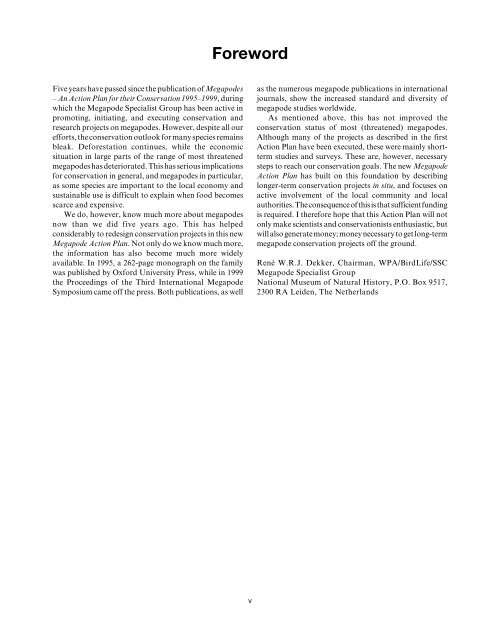Megapodes: Status Survey and Conservation Action Plan ... - IUCN
Megapodes: Status Survey and Conservation Action Plan ... - IUCN
Megapodes: Status Survey and Conservation Action Plan ... - IUCN
Create successful ePaper yourself
Turn your PDF publications into a flip-book with our unique Google optimized e-Paper software.
Foreword<br />
Five years have passed since the publication of <strong>Megapodes</strong><br />
– An <strong>Action</strong> <strong>Plan</strong> for their <strong>Conservation</strong> 1995–1999, during<br />
which the Megapode Specialist Group has been active in<br />
promoting, initiating, <strong>and</strong> executing conservation <strong>and</strong><br />
research projects on megapodes. However, despite all our<br />
efforts, the conservation outlook for many species remains<br />
bleak. Deforestation continues, while the economic<br />
situation in large parts of the range of most threatened<br />
megapodes has deteriorated. This has serious implications<br />
for conservation in general, <strong>and</strong> megapodes in particular,<br />
as some species are important to the local economy <strong>and</strong><br />
sustainable use is difficult to explain when food becomes<br />
scarce <strong>and</strong> expensive.<br />
We do, however, know much more about megapodes<br />
now than we did five years ago. This has helped<br />
considerably to redesign conservation projects in this new<br />
Megapode <strong>Action</strong> <strong>Plan</strong>. Not only do we know much more,<br />
the information has also become much more widely<br />
available. In 1995, a 262-page monograph on the family<br />
was published by Oxford University Press, while in 1999<br />
the Proceedings of the Third International Megapode<br />
Symposium came off the press. Both publications, as well<br />
as the numerous megapode publications in international<br />
journals, show the increased st<strong>and</strong>ard <strong>and</strong> diversity of<br />
megapode studies worldwide.<br />
As mentioned above, this has not improved the<br />
conservation status of most (threatened) megapodes.<br />
Although many of the projects as described in the first<br />
<strong>Action</strong> <strong>Plan</strong> have been executed, these were mainly shortterm<br />
studies <strong>and</strong> surveys. These are, however, necessary<br />
steps to reach our conservation goals. The new Megapode<br />
<strong>Action</strong> <strong>Plan</strong> has built on this foundation by describing<br />
longer-term conservation projects in situ, <strong>and</strong> focuses on<br />
active involvement of the local community <strong>and</strong> local<br />
authorities. The consequence of this is that sufficient funding<br />
is required. I therefore hope that this <strong>Action</strong> <strong>Plan</strong> will not<br />
only make scientists <strong>and</strong> conservationists enthusiastic, but<br />
will also generate money; money necessary to get long-term<br />
megapode conservation projects off the ground.<br />
René W.R.J. Dekker, Chairman, WPA/BirdLife/SSC<br />
Megapode Specialist Group<br />
National Museum of Natural History, P.O. Box 9517,<br />
2300 RA Leiden, The Netherl<strong>and</strong>s<br />
v
















